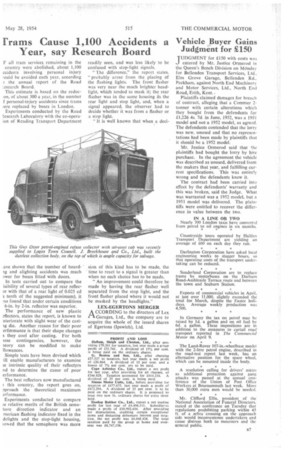frams Cause 1,100 Accidents a Year, say Research Board
Page 41

If you've noticed an error in this article please click here to report it so we can fix it.
F all tram services remaining in the country were abolished, about 1,100 ccidents involving personal injury rould be avoided each year, according 3 the annual report of the Road iesearch Board.
This estimate is based on the reducon, of about 300 a year, in the number I personal-injury accidents since trams /ere replaced by buses in London.
• Experiments conducted by the Road tescarch Laboratory with the co-operaLon of Reading Transport Department
ave shown that the number of boardig and alighting accidents was much Dwer for buses fitted with doors.
In tests carried out to compare the isibility of several types of rear reflecor with that of a rear light of 0.025 cd a tenth of the suggested minimum), it ras found that under certain conditions 6-in. by 2-in, reflector was superior. The performance of new plastic 2ilectors, states the report, is known to eteriorate with slight wear of the castig die. Another reason for their poor erformance is that their shape changes s they cool after casting. For both iese contingencies, however, the ieory can be modified to make lIowances.
Simple tests have been devised which ill enable manufacturers to examine te intrinsic quality of their reflectors ad to determine the cause of poor erformance.
The best reflectors now manufactured this country, the report goes on, aproach the theoretical maximum :.rformance.
Experiments conducted to compare ie relative merits of the British semahare direction indicator and an merican flashing indicator fixed in the delights and the stop-light housing, lowed that the semaphore was more
readily seen, and was less likely to be confused with stop-light signals.
" The difference," the report states, "probably arose from the placing Of the flashing lights. The front flasher was very near the much brighter headlight, which tended to mask it; the rear flasher was in the same housing Ss the rear light and stop light, and, when a signal appeared, the observer had to decide whether it was from a flasher or a stop light.
"It is well known that when a deci sion of this kind has to be made, the time to react to a signal is greater than when no such choice has to be made.
"An improvement could therefore be made by having the rear flasher well separated from the stop light, and the front flasher placed where it would not be masked by the headlights."
LEX-EGERTONS MERGER
A CCORDING to the directors of Lex A-1 Garages, Ltd., the company are to acquire the whole of the issued shares of Egertons (Ipswich), Ltd.




































































































